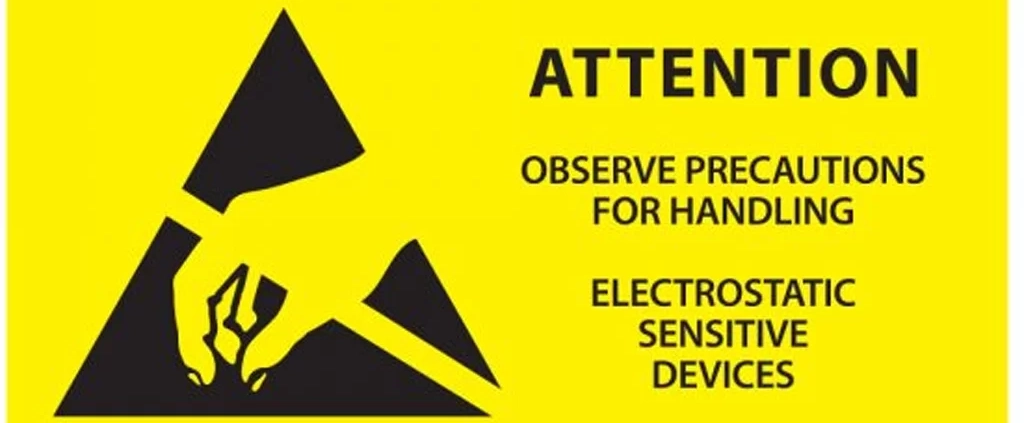Electrostatic discharge sensitive components (ESD or ESDS components) are electronic devices that can suffer damage when subjected to static electricity. This damage can manifest in various forms, from sudden complete failure to potential slow failure. Understanding these failure modes is essential for developing strategies to prevent or mitigate the impact of electrostatic discharge on ESDS components. In this article, we will explore the different failure modes of components due to electrostatic discharge, common failure modes and phenomena caused by ESD damage, and the mechanism of static damage to solid-state drives (SSD).
ESD Damage Failure Modes of Components
Sudden Complete Failure
One of the most common and severe failure modes of ESDS components is sudden complete failure. This type of failure occurs instantaneously when a component is exposed to an electrostatic discharge event, causing irreversible damage to the device. Sudden complete failure often results from a high voltage discharge directly affecting the device’s internal structure, such as a gate oxide breakdown in a transistor. This type of failure is often easily detectable, as the device will no longer function correctly or at all.
Potential Slow Failure
In contrast to sudden complete failure, potential slow failure is a less obvious but no less significant issue for ESDS components. This type of failure refers to the gradual degradation of a device’s performance over time due to repeated or prolonged exposure to electrostatic discharge events. The accumulation of damage from multiple low-voltage discharge events can lead to the eventual failure of the component, even if no single event was severe enough to cause immediate catastrophic damage.
Potential slow failure is particularly concerning because it can be challenging to diagnose and predict, as the component may still function within acceptable specifications for some time before eventually failing.
Common Failure Modes Caused by Electrostatic Discharge Damage
There are several common failure modes that can occur in ESDS components due to electrostatic discharge damage, including:
- Gate oxide breakdown: A high-voltage ESD event can cause the gate oxide layer in a transistor to rupture, creating a conductive path between the gate and substrate. This results in a short circuit, leading to the failure of the transistor.
- Junction damage: The high current generated during an ESD event can cause localized heating and melting of semiconductor material, creating defects in the junctions of transistors or diodes. This can lead to increased leakage current, reduced breakdown voltage, or complete failure of the device.
- Metal migration: The high temperatures generated during an ESD event can cause metal interconnects to diffuse into the surrounding material, creating short circuits or open circuits in the device.
- Latent damage: ESD events can cause damage that may not be immediately apparent but can result in the long-term degradation of the component’s performance. This can include damage to insulation layers or the creation of microscopic defects in the semiconductor material.
Failure Phenomena Caused by Electrostatic Discharge Damage
In addition to the specific failure modes discussed above, several failure phenomena can be observed in ESDS components due to electrostatic discharge damage:
- Parametric failures: These are failures in which the device continues to function but with degraded performance, falling outside of its specified operating parameters. Parametric failures can result from a variety of damage mechanisms, including gate oxide breakdown and junction damage.
- Catastrophic failures: These are failures in which the device ceases to function entirely, often as a result of a short circuit or open circuit caused by ESD damage. Catastrophic failures can be the result of any of the failure modes discussed above.
- Intermittent failures: These are failures that occur sporadically and are often difficult to diagnose. Intermittent failures can result from latent damage caused by ESD events or from the gradual degradation of a component due to potential slow failure.
Mechanism of Static Damage to SSD
Solid-state drives (SSD) are a type of ESDS component that can be particularly susceptible to electrostatic discharge damage due to their high density of sensitive electronic components and reliance on precise signal timing. The primary mechanism of static damage to SSDs involves the creation of a conductive path between two or more points within the device, either through gate oxide breakdown or metal migration.
This conductive path can result in a variety of failure modes, including short circuits, open circuits, and increased leakage current. Additionally, SSDs are susceptible to potential slow failure due to the accumulation of minor ESD damage over time, which can result in the gradual degradation of the drive’s performance and eventual failure.
Summary
Electrostatic discharge sensitive components, including solid-state drives, are susceptible to a variety of failure modes due to ESD damage. Understanding these failure modes and the mechanisms behind them is critical for developing strategies to prevent or mitigate the impact of ESD events on these components. Sudden complete failure, potential slow failure, and common failure modes such as gate oxide breakdown, junction damage, and metal migration can all lead to the degradation or complete failure of ESDS components. Additionally, failure phenomena such as parametric failures, catastrophic failures, and intermittent failures can provide further insight into the effects of ESD damage on electronic devices.
To protect ESDS components from ESD damage, it is essential to implement proper handling procedures, use appropriate ESD protection devices, and design systems with ESD robustness in mind. By understanding the various failure modes and mechanisms associated with ESD damage, engineers and technicians can better anticipate potential issues and implement solutions to safeguard sensitive electronic components against the damaging effects of electrostatic discharge.




Leave a Reply
Want to join the discussion?Feel free to contribute!